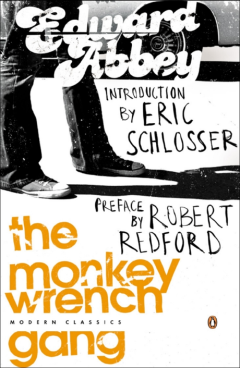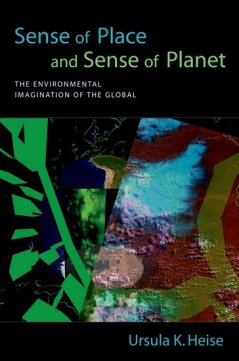This month from the archive: Patrick Murphy writes about the books that meant most as he developed as an environmentalist. Originally published in 2017:
The books that helped me become an environmentalist came along at key moments in my intellectual development. Looking back, they were equal parts timely and apart of the times. They often came to me from an important person in my life.
I was born in the 1960s and grew up in the 1970s, so in many ways I am a child of America’s environmental movement. I was six years old when the first Earth Day was celebrated. To commemorate this new national day, students in my elementary school were encouraged to think about the planet by planting trees. But even prior to this explicitly eco-conscious event, like most young people at that time my perception of life on Earth had been profoundly shaped by other social forces. Cold war politics cultivated the dark realization that humankind had the power to blow up the planet. And of course it was no coincidence that the emerging Earth consciousness of the time was sparked by the “race to the moon.” NASA had given us Earthlings a way to look at our home planet from the vastness of space, thus reframing our view from the outside peering back on a singularly beautiful yet fragile place. Suddenly there was a collective realization that we had a responsibility to cherish and protect our home.

There was a host of important literature that sparked this awakening, including Rachel Carson’s Silent Spring (1962), R. Buckminster Fuller’s Operating Manual for Spaceship Earth (1969), and Paul Ehrlich’s The Population Bomb (1969). But during this time the books that young children were steered toward included, among others, Shel Silverstein’s The Giving Tree (1964) and Dr. Seuss’s The Lorax(1971). These asked us not only to think about things like trees but also more progressively to “speak for the trees.” It was, for many of my generation, a nascent registering of environmental limits as these illustrated tales of humankind’s degradation of nature underscored our blind anthropocentrism.

This early reading list, inauspicious and elementary as perhaps it was, nevertheless seeded a path towards a deeper eco-conscious curiosity. I was lucky to have people in my life that suggested more writers and their books to help me continue down the road of environmentalism. For instance, my Uncle Michael’s regular practice when visiting was to show up with several books in tow. “Pick one, and you can borrow it.” He was always willing to share. Through such exchanges I encountered Emerson’s Nature and Thoreau’s “Walking,” which in different ways made cases for the spiritual allure of wilderness and its healing properties. After reading these, my appreciation for time spent in the woods was never quite that same.

Some years later I ended up with a 1988 edition of Christopher D. Stone’s Should Trees Have Standing, which argued for the legal status of trees and other nonhuman entities. The philosophical cast of this essay pushed me to consider the profoundly important moral and legal dimensions of ecocentric thinking. Stone asserted that, while extending rights to previously rightless groups (e.g., women, minorities, children, convicts) may have seemed odd or frightening for some at the time, the value of moving these rights from “the unthinkable” to “the thinkable” was crucial. So, maybe the notion that the earth should have its own rights should not be such a radical idea. But, even today, we seem far off from that and there remains much work to do. The earth itself, at least in the West, remains “the other.”

Another “book person” in my life was my older brother, who always had a true love for trees. As he was considering becoming a forest ranger he gobbled up vast quantities of Edward Abbey. Abbey had grown up not far from where we lived in Pennsylvania, so my brother felt connected to him while also sharing his distaste for authority. For my brother, Desert Solitaire (1968) and The Monkey Wrench Gang (1975) were requisite reading for anyone even remotely concerned with the widening gap between modern society and natural places. As I picked up these books I became convinced that my brother was equal parts Abbey and George Hayduke, the iconic agent of eco-mayhem of several of Abbey’s novels, and began to develop a fuller sense of the antagonisms at play within environmentalism, particularly between preservationism and conservationism.
To say that my anthropologist father was an avid reader would be an understatement. Not only did he have books in his living room and bedroom, they were found in the kitchen and bathroom and stacked in the hallways. His collection profoundly shaped my interest in the global south, particularly Latin America. As a result I found myself seeking out books that could help me understand the environmental histories of non-Western regions. A recent favorite of mine is An Environmental History of Latin America (2007) by Shawn William Miller, which, from plants to germs to guano, expertly charts the region’s long struggle between humans and nature.

To help satisfy my growing appetite for environmental work, some years back a political scientist friend suggested John S. Dryzek’s The Politics of the Earth(1997). In Dryzek’s work I found a theoretical foundation ripe for considering some of the broader questions I was wrestling with about capitalist expansion and environmental stewardship within the age of globalization. As a media scholar, this was a transformative book, one that provide me with the conceptual tools to pursue in earnest my own interest on media, power and environmental politics, particularly in relation to representations of nature and the environmental imagination. Along these lines Ursula K. Heise’s Sense of Place and Sense of Planet: The Environmental Imagination of the Global (2008) was the perfect companion to the literature I was familiar with about globalization, permitting me to dig deeper into questions of globality, environmentalism and the politics of representation.
Finally, in these past few years I’ve become increasingly interested in globalization, consumption and waste. One of the more important books to come out in the last few years, at least for my teaching, is Richard Maxwell and Toby Miller’s Greening the Media (2012), an exploration of that most-hidden-in-plain-view fruit of the information society, e-waste. In this book, the exponential growth of toxic dumps in the global south and the bleak realities the ragpickers who work them are juxtaposed with the consumer excesses computer and mobile phone users of the global north and the “planned obsolescence” of the industries that create them. For anyone who owns a computer or cell phone, this should be required reading.
From the limits discourse of the 1970s to the more complex discursive terrain of today’s environmentalism, these books have helped me make sense of a planet in crisis. Although there continues to be much to worry about and plenty to be done, theses books identify unsustainable practices and frame a vision of environmental stewardship that is necessary to create a more thoughtful relationship with the earth.

Patrick Murphy is Associate Dean for Research and Graduate Studies of the Klein College of Media and Communication at Temple University. His latest book is The Media Commons: Globalization and Environmental Discourses (University of Illinois Press, 2017).

